Menus
- Two screwdrivers, three cylinders, one project
- Hands off the triple
- Wheels, suspension and brakes
- Suspension doesn’t work at all
- "Hello! We bring the triumph!"
- TÜV test drive lasted 45 minutes
- She is besieged at biker meetings
- Have you also restored a classic??

Thomas Degree
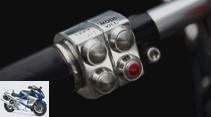
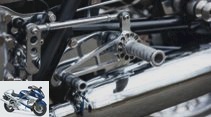
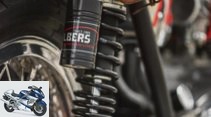
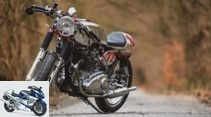
10 photos
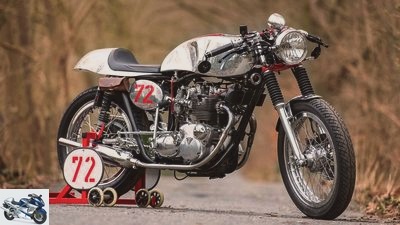
Thomas Degree
1/10
Triumph Trident Cafe Racer
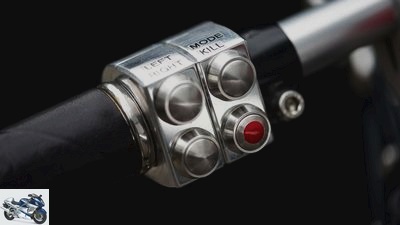
Thomas Degree
2/10
The handlebar fittings milled from aluminum by Motogadget look great and can be assigned as desired
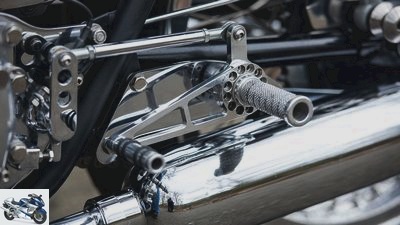
Thomas Degree
3/10
Precision work: The footrests milled from aluminum are fully adjustable, the rods are lovingly adapted
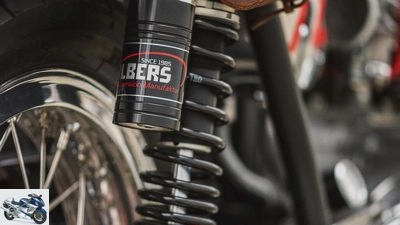
Thomas Degree
4/10
Blackline stereo struts specially adapted by Wilbers are used at the rear.
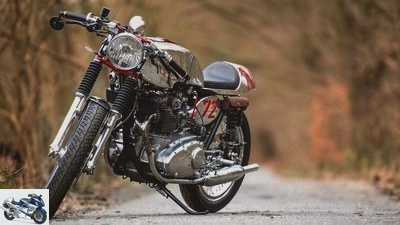
Thomas Degree
5/10
The machine invites the viewer to enjoy the many small, elegantly manufactured individual solutions
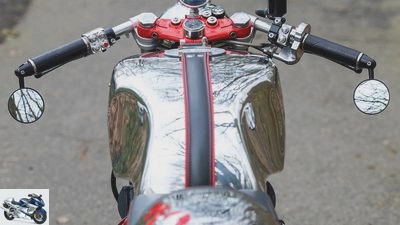
Thomas Degree
6/10
Coherent all round: long tank, slim waist, small, round hump, everything in polished aluminum or in the colors red and black
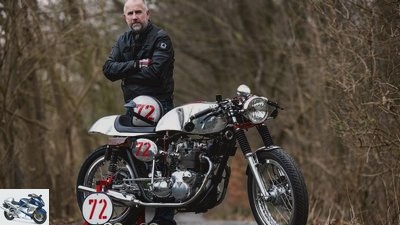
Thomas Degree
7/10
The builder and his work: The best way to take a break is lonely in the forest, at the biker meeting the amazed bystanders are pestering with questions.
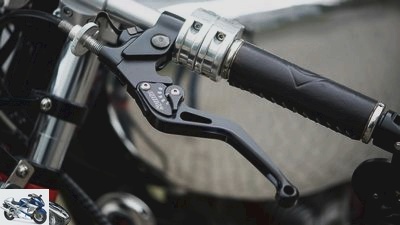
Thomas Degree
8/10
Triumph Trident Cafe Racer.
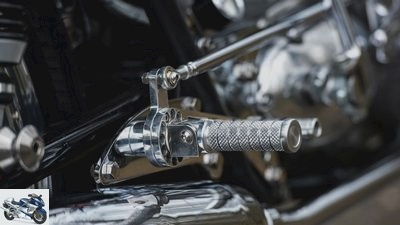
Thomas Degree
9/10
Triumph Trident Cafe Racer.

Thomas Degree
10/10
Triumph Trident Cafe Racer.
Triumph Trident Cafe Racer reader conversion
Two screwdrivers, three cylinders, one project
Content of
The idea of getting a Triumph Trident as the basis for a Cafe Racer conversion was born quickly. The implementation, on the other hand, required a lot of time and detailed work, but the result is impressive.
"Anyone can do two-cylinder", was the answer to the question my co-screwdriver Peter Jungton asked why I chose this bike. This had preceded a long time full of deliberations as to which model would be suitable for converting into a cafe racer. We agreed on a triumph. Peter probably assumed a Bonneville or Thruxton, but when I saw this Triumph Trident in the Meilenwerk in Stuttgart, I couldn’t help it. It looked like it was parked there and forgotten by Kiss bassist Gene Simmons in glittery platform boots and bell bottoms in the 1970s. So off to a test drive. Switch on the ignition, open both gas taps, dab the carburetor and kick – she was there and received me with a sonorous roar from her peeshooters. “Remember,” warned the salesman, “shift right and brake left.” Okay, I can do that. So go in first gear and go. Even after my return I couldn’t get rid of the grin that had accompanied me the whole time during the journey. After that everything went very quickly: Sign the contract, pay, put it on the trailer and off to the Bergisches Land.
Buy complete article
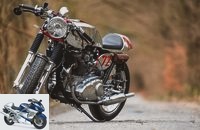
Triumph Trident Cafe Racer reader conversion
Two screwdrivers, three cylinders, one project
Classic basis and modern technology
My idea of a cafe racer was clear: it should have a classic base, but be equipped with modern and safe technology. A list of suitable accessories already existed, but it was clear to me that a lot of manual work would still be required here. So off to work. First the Triumph Trident was stripped. When taking it apart, there was another insight: The English not only switch to the right, brake left and drive on the wrong side of the road, but also clamp the positive pole to ground! So the wiring harness also had to be taken out. After the revision of the frame by removing the no longer required fastening points, flexing, welding on new fastenings, smoothing and painting, a new wiring harness was laid. This could be extremely slimmed down with new components from Motogadget. The heart of the new electrics is the new Motogadget M-Unit. Then there are the beautiful dashboard buttons and an RFID ignition lock from the same manufacturer. The ignition is now switched on by a “key” integrated in my glove on my finger. In the course of this work, a new Boyer ignition with power box was installed. That saved me the installation of the rectifier and a zener diode. The entire electrical system is now located under the tank, neatly screwed onto a stainless steel plate, its new home. After the three huge ignition coils had been moved to a new place under the tank and everything was rewired, the first attempt at starting followed. It was almost scary – she jumped right on the second courageous step!
Hands off the triple
It went on – next was the engine. Due to the excellent preparatory work in England, we were able to greatly reduce working hours here. The engine of the Triumph Trident has already been overhauled in the company of Les (L. P.) Williams, manager of the Triumph motorcycle racing team from the 70s, and some points have been improved. After all, the good man knows his way around, as the works racer “Slippery Sam” was based on a Triumph T150 and achieved many victories in the 1970s. So hands off the triple! Above all, it is tight and powerful. On the carburetor side, however, there was a lot to do. The trio was completely dismantled, cleaned and worn parts replaced. The filter box has been removed so that the engine can now breathe freely through open funnels. But anyone who knows Amal carburetors knows that this cannot be done by the way. After additional slight modifications to the carburetor, we removed the complete carburetor bridge including the carburetor, drilled a hole through the bridge into the inlet ducts and screwed connections for a synchronous tester. After tuning, the mixture preparation now works much better.
Wheels, suspension and brakes
Next on the list: wheels, suspension and brakes. The old rims of the Triumph Trident had to believe in them. They looked very battered so I decided to replace them. The hubs were dismantled, cleaned, polished and spoked into beautiful Akront high-shoulder rims. Since Triumph used a Lockheed disc brake for the first time on the T150 and this still had considerable advantages over the drum brake, I largely kept it. A modified original brake disc (perforated) was installed and the brake cylinder was replaced by an identical type made of aluminum. A 12-millimeter Magura combination now pumps the fluid to the brake pistons from the other end of the steel flex line. I found the rear drum brake installed by the factory to be usable throughout. Only the speedometer connection was removed from the rear wheel, as this information is now taken from a reed sensor on the front wheel.
Suspension doesn’t work at all
But what didn’t work, Peter and I agreed, was the suspension of the Triumph Trident. The aft-mounted jampots were intended more for cruising than for species-appropriate cafe racer movement. It looked the same way up front. The original fork did not convey any real noticeable contact with the road. However, we were able to counteract this with progressive Wilbers springs and stronger preload. Benny Wilbers was then able to supply us with a set of his Blackline dampers for the rear. After querying various parameters, he was able to present us with an optimal set of adapted stereo struts after three weeks. Our rolling chassis and engine were now ready. It was time to let an artist get to work – the lady is getting a new dress.
"Hello! We bring the triumph!"
In Friedhelm Lammers’ workshop in Wietmarschen, it is Nordic-cool. A brief “Moin” sounds after the roller door has been raised. “Hello! We bring the Triumph Trident, ”I reply. “Well, let’s get on with it.” Of course, I had already informed myself beforehand and saw Friedhelm as the most suitable – I wanted to entrust him with my T150 and should not be disappointed. After I had described my idea to him and he showed me a few drafts, I received a call after a few weeks of not using a screwdriver, saying I could pick up the machine again. It was already in the yard, and when I saw the mirror-polished aluminum on the Triumph, I felt happy. Everything done right, he implemented everything 100 percent. The British woman now has a new dress, consisting of a small front fender, a long tank that sweeps into the seat hump and ends just as curvy in a hump with a wasp waist. The oil tank with integrated battery compartment is just as clever. It fits perfectly into the frame triangle. Let’s go home with it.
TÜV test drive lasted 45 minutes
Freshly motivated to bring my performance to an end, it went straight on the next day. A few parcels had been delivered early in the morning, they contained a Motogadget Motoscope Classic speedometer with Streamline Cup, Kellermann indicators for the front and rear and a clip-on handlebar. These parts fit inconspicuously into the overall concept of the racer. By no means was here just unpacking and screwing on. To mount the speedometer and various other attachments, brackets first had to be made. Drafts were drawn with cardboard, pencil and scissors, cut out and then sawed in stainless steel or aluminum, milled, turned and polished to a high gloss. Such custom-made items can be found in many places. Speaking of one-off production: You should pay particular attention to the footrest system. It is milled from aluminum and can be adjusted horizontally and vertically. By relocating the notches to the rear, the linkage for shifting and braking also had to be adapted – everything was done by myself. Small side note: Yes, everything was registered by the TÜV! The Triumph Trident Cafe Racer stood at the TÜV for six days for final acceptance and I had to make some changes in accordance with the law and submit various drawings, calculations, material reports and certificates, but in the end I got the blessing of the TÜV official. His last test drive lasted 45 minutes – he must have enjoyed it…
She is besieged at biker meetings
The combination of polished aluminum and red / black paint has something magical about it. I made sure that only these colors were used. The leather work, such as the tank strap in two colors, the seat upholstery with red stitching or the handles in black leather with football stitching, meet this requirement. I am delighted every time I do my laps through the Bergisches Land with this machine. It is besieged at all the well-known biker meetings, and sometimes I can hardly get away because I have to answer so many questions. It was confirmed in 2015 that Peter and I implemented the project correctly. At the nationwide Cafe Racer Forum meeting, the Triumph Trident Cafe Racer achieved second place as “most elaborate cafe racer 2015” and first place as “most beautiful cafe racer 2015”. Well done, the Englishman would say. The British will actually have the opportunity to marvel: The main prize for first place is a trip to the Ace Cafe in London. The lady will definitely feel at home there.
Have you also restored a classic??
Have you also restored a classic or rebuilt contemporary? Then send us text and pictures:
MOTORRAD Classic editorial team,
Leuschnerstrasse 1, 70174 Stuttgart
or by email to motorradclassic@motorpresse.de
Related articles
-
Triumph Thruxton RS (2020): New cafe racer with power plus
Motorcycle fair in Milan EICMA 2019 Presented by Jorg Kunstle 25th photos triumph 1/25 The new cafe racer has a fresh look. triumph 2/25 The twin upswept…
-
Icon Motorcycles Triton: Cafe racer with Triumph technology
Icon Motorcycles 14th photos Icon Motorcycles 1/14 Icon Motorcycles from the Netherlands builds modern cafe racers by hand. Icon Motorcycles 2/14 The…
-
Jahn Compare Cafe Racer, Buell XB12R Firebolt, Moto Guzzi V 11 Le Mans, Voxan Cafe Racer Cafe, curves and character With the idiosyncratic two-cylinder…
-
Gargolov 9 photos Gargolov 1/9 Louis spokesman and motorcycle fanatic Kay Blanke, mastermind behind the NX project. Gargolov 2/9 A cheeky cafe racer who…
-
On the road with the BMW K 75, Triumph Trident T150 and Yamaha XS 750
fact 34 photos www.factstudio.de 1/34 Picture gallery, On the move: BMW K 75, Triumph Trident T150, Yamaha XS 750. www.factstudio.de 2/34 If you are into…
-
Ducati Scrambler Cafe Racer driving report
Ducati 20th photos Ducati 1/20 Ducati Scrambler Cafe Racer Ducati 2/20 Ducati Scrambler Cafe Racer Ducati 3/20 Historical quotations everywhere. The…
-
Blacksmith 16 photos Blacksmith 1/16 The three-cylinder requires sensitivity, you have to put yourself in it. Blacksmith 2/16 The oil channel of the left…
-
Self-made Cafe Racer based on Suzuki TS 400
Blacksmith 15th photos Blacksmith 1/15 It’s hard to believe that this once was a completely rotten 400cc Suzuki enduro. The French Henri Mahe breathed…
-
Moto Guzzi conversion Doc Jensen Racer No. 59
Siemer 20 pictures Fred Siemer 1/20 Moto-Guzzi conversion Doc Jensen Racer No. 59. Fred Siemer 2/20 Moto-Guzzi conversion Doc Jensen Racer No. 59. Fred Siemer 3/20 …
-
Gargolov 10 photos Gargolov 1/10 The motorcycle speaks for itself, the creators call author Henniges all the important information. Gargolov 2/10…